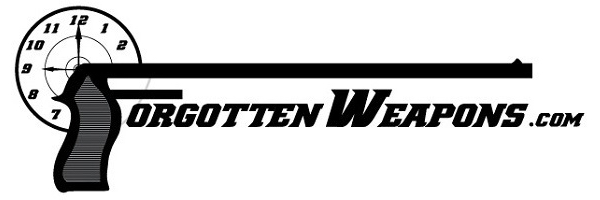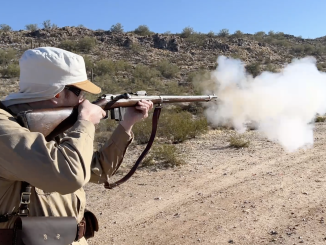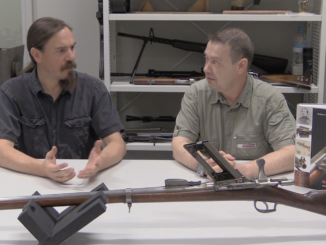For the full episode with the hand loading instructional section, click here:
https://forgottenweapons.vhx.tv/videos/episode-7-beaumont-app
Black powder military rifles of the 1860s-1880s are a really enjoyable group of guns. A lot of them are relatively reasonably priced, and they are actually pretty easy to reload for. The unavailability of factory ammunition (for most, although not so much for the Trapdoor) makes them seem like a daunting prospect, but for a pretty simple investment in tools and time one can make up ammunition and have a lot of fun with rifles like this.
That’s the idea behind a new series here on black powder military rifles. Each month, my friend – and handloader – Tom and I will take out a different model to have some fun at the range and compare how they handle. And then we will show you how to make the ammunition for them. So grab your pith helmet, pause “Zulu” and join us! Today is Episode Seven: 1871 Beaumont!




Nice, I have 2 Beaumont Vitali’s (Maastricht and Delft contract) and a navy and army Beaumont (both with cleaning rod!), but never saw it being shot. Thank you!
I have originals of 1861 Union rifled musket and a Springfield trapdoor. I would never risk my face and hands shooting them. Hats off to Ian and Tom in taking the risk to show off these guns.
According to Cartridges of the World 11th edition the 11mm Beaumont can be fired with the 11mm Egyptian.
Buffalo Arms has lots of oddball cartridges, even though the availability comes and goes. They will sometimes have loaded ammo and cases for both the Beaumont and Egyptian 11mm.
https://www.buffaloarms.com/
“(…)Black Powder(…)Beaumont(…)”
Was is surprising for me, is that said weapon has spring inside bolt handle. Why is this?
How else would one use a leaf spring to power a firing pin in a turn-bolt action?
Somebody had (what they thought) was a bright idea and was able to talk management into using it. Not sure if this is a good idea, a bad idea, or it really does not matter as long a the rifle works.
Here is a link to a article on the rifle’s development.
https://www.militaryrifles.com/netherlands/beaumont71
I think I read somewhere that they could not produce coil-springs in the netherlands back then, so they went with leaf-springs instead.
This seems odd, considering that 1870s military rifles made in Europe like Mauser Modell 1871 and Fusil Modèle 1874 Gras did include such springs. Was KINGDOM OF NETHERLANDS was retro-grade technology-wise w.r.t other European nations in 1970s?
is: “1970s”
should be: “1870s”
Leaf springs were a known technology, and easy to produce during the era. Not so much coil springs, which were only then really coming into use for firearms. Every armorer and artisan knew how to do “leaf spring”, and not all of them were familiar with the intricacies of coil springs.
This seems somewhat ludicrous to us today, but… It was a thing. You can find people writing about their objections to the new-fangled coil springs, which they worried about “taking a set” and all the rest. Leaf springs were well-understood, and everyone trusted them.
Which ain’t to say that any of that was at all rational, but there ya go… I think there’s a very strong component of “culture” to every design and mechanism, one which we underestimate to our peril.
Case in point would be the way the bow was considerably more lethal and effective in the hands of trained archers for decades following the development of firearms. Why’d firearms come out on top? The training requirements, and the attraction of “Big Noise” for poorly-trained conscripts, who were both encouraged by their own ability to make big noises at the enemy, and discouraged by the enemy’s big noises in turn. You can analyze many early firearms battles as basically being conducted by and for sound effect…
Which makes no damn sense to us, but it made plenty to the people of the era.
An early example of suppression. Much as l love marksmanship, there is something about noisy, preferably rapid or large-scale – and preferably automatic – fire that makes most enemy soldiers stop moving and get the heck down, or run away.
I think it’s a reason why in the C20th, 9mm (and similar) SMGs did better than analysis suggested they would. The manual said fire single rounds or short bursts. The combat reality was blaze off a half or a third of a mag. You may not have hit anything, but unless your opponents were bloody hench, they’d – if not hit – be lying in ditches or hiding behind trees and walls, while your fellow soldiers flanked them and took them out of the equation.
You want me in my near-dotage to defend a position against infantry with small arms? Give me an MG42 with 1000 rounds.
We are already shocked and awed by verbiage alone. Proof that bark trumps bite. Sun Zi muffed that maxim, he did.
The old saying was that to train an archer, you started by training his grandfather. Yes, it took two or three generations of makee-learnee to create the “archery armies” of the pre-gunpowder era.
and that was about how long it took to have a store of longbows. between choosing the wood, cutting it, seasoning it, tillering it, and etc., it took a couple of years per bow, and only skilled craftsmen (called “bowyers”- “Arrowsmiths” made the arrows) could manufacture a bow that wouldn’t snap or shatter on the first full draw.
Then of course there was the storage problem. Wood self-bows or even composite bows don’t react well to major changes in temperature and humidity. To say nothing of how bowstrings can act.
By comparison, the gun was simpler and faster to make- any blacksmith could make a “hand cannon”. Its ammunition was simple; cast lead balls. Training could be done in an hour or so. The only limitations were rate of fire (one round every couple of minutes was good, but volley fire by ranks could make up for that) and getting the gunpowder to begin with. Sulfur from springs and charcoal were no problem in Europe (Iceland did a land-office business in sulfur), but saltpeter- potassium nitrate- was harder to come by. (Digging up privies and excavating caves full of bat guano got you calcium nitrate, not quite the same thing.)
And no, the crossbow wasn’t the happy medium. It had all the production problems of the longbow. Its sole virtues were being easier to train somebody to hit something with than a longbow, and being almost as good at punching through plate armor at short range as the gun.
The fact is that due to easier production and training and better performance overall, it was the gun that put feudalism out of business. The longbow and crossbow weren’t quite up to the job, no matter what romantics and classicists think today.
And no, the Native Americans didn’t oppose “Manifest Destiny” with bows and arrows, or even “trade muskets”. They mostly used Spencers, Henrys, and Winchesters.
Firearms in the Indian Wars 1862-1890 Don Rickey Jr. 1950
https://core.ac.uk/download/215275608.pdf
Yes. Hollywood got it almost entirely wrong.
And quite a few “interests” back East were involved in trying to stop the Western settlement program.
clear ether
eon